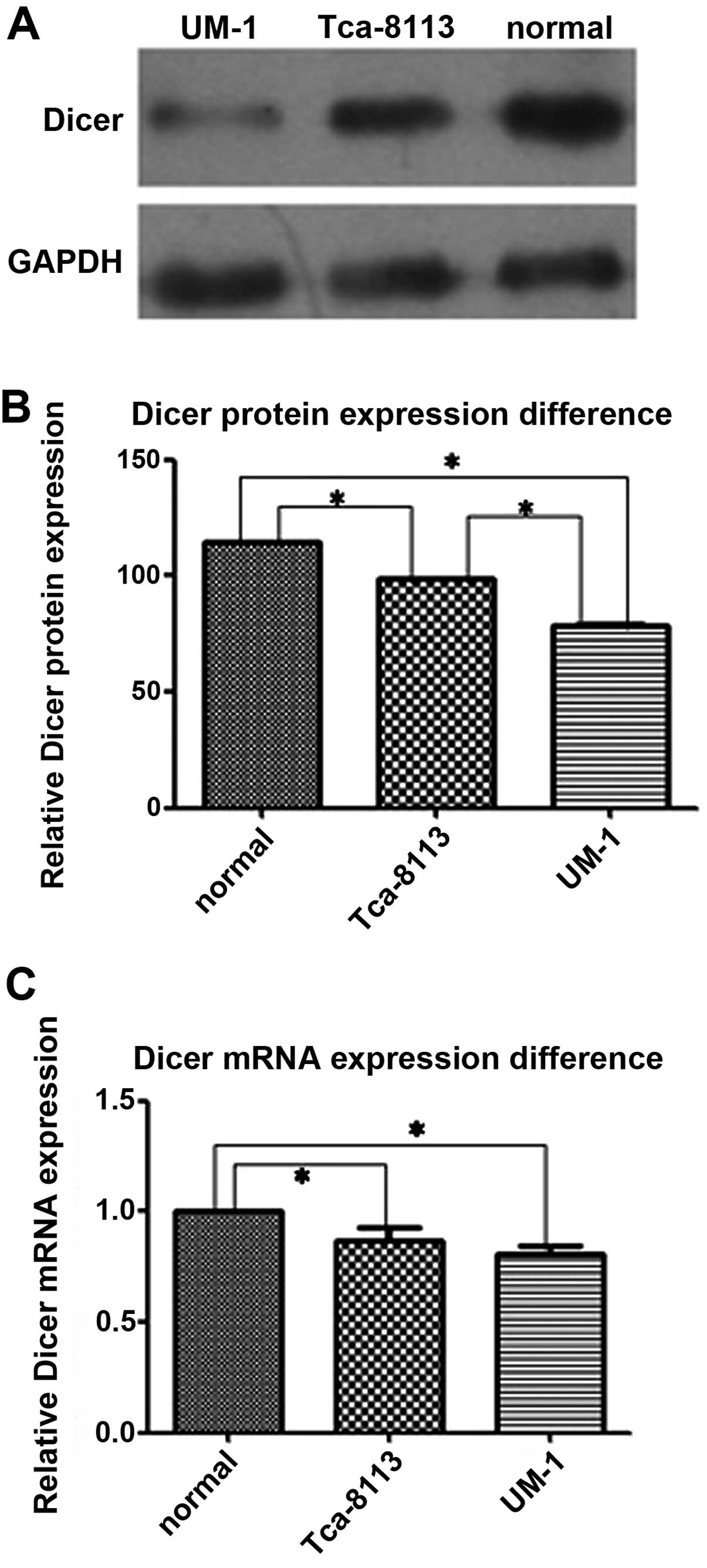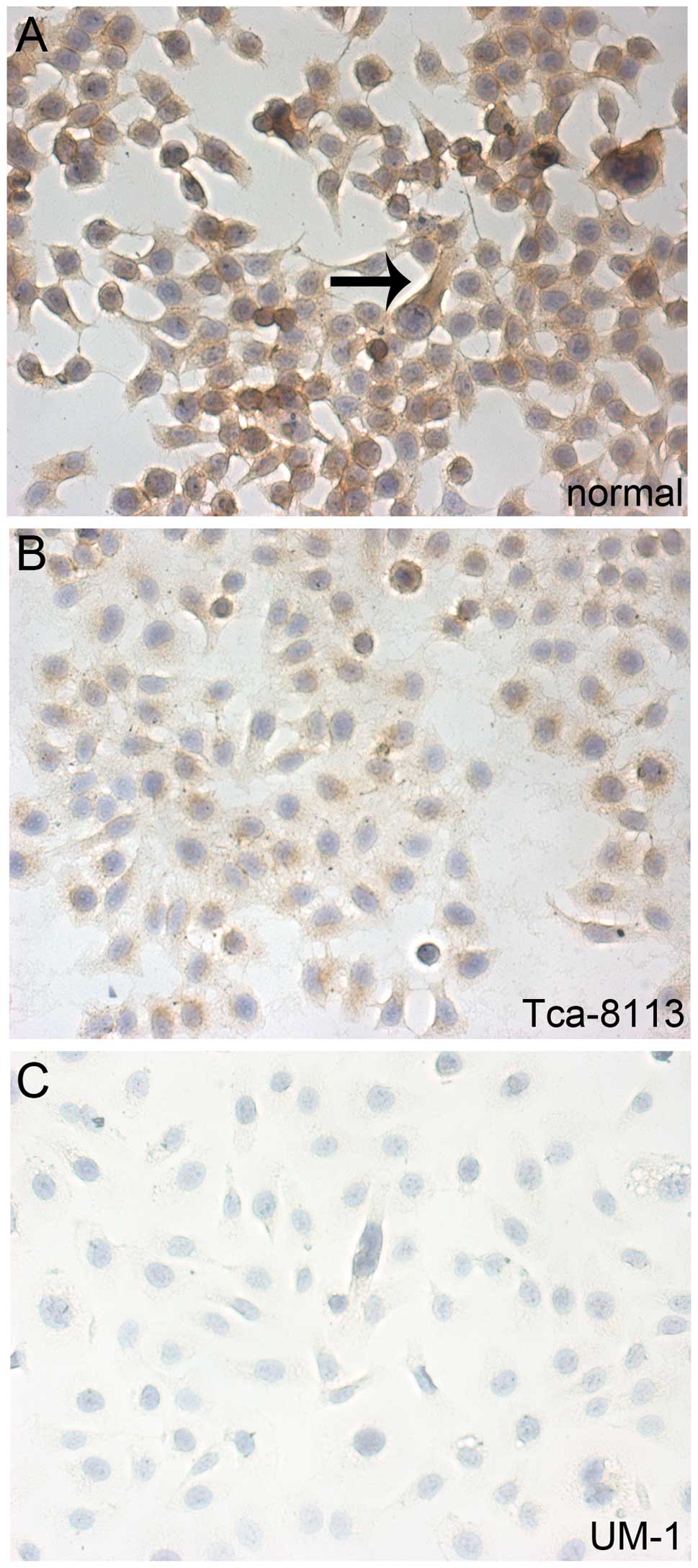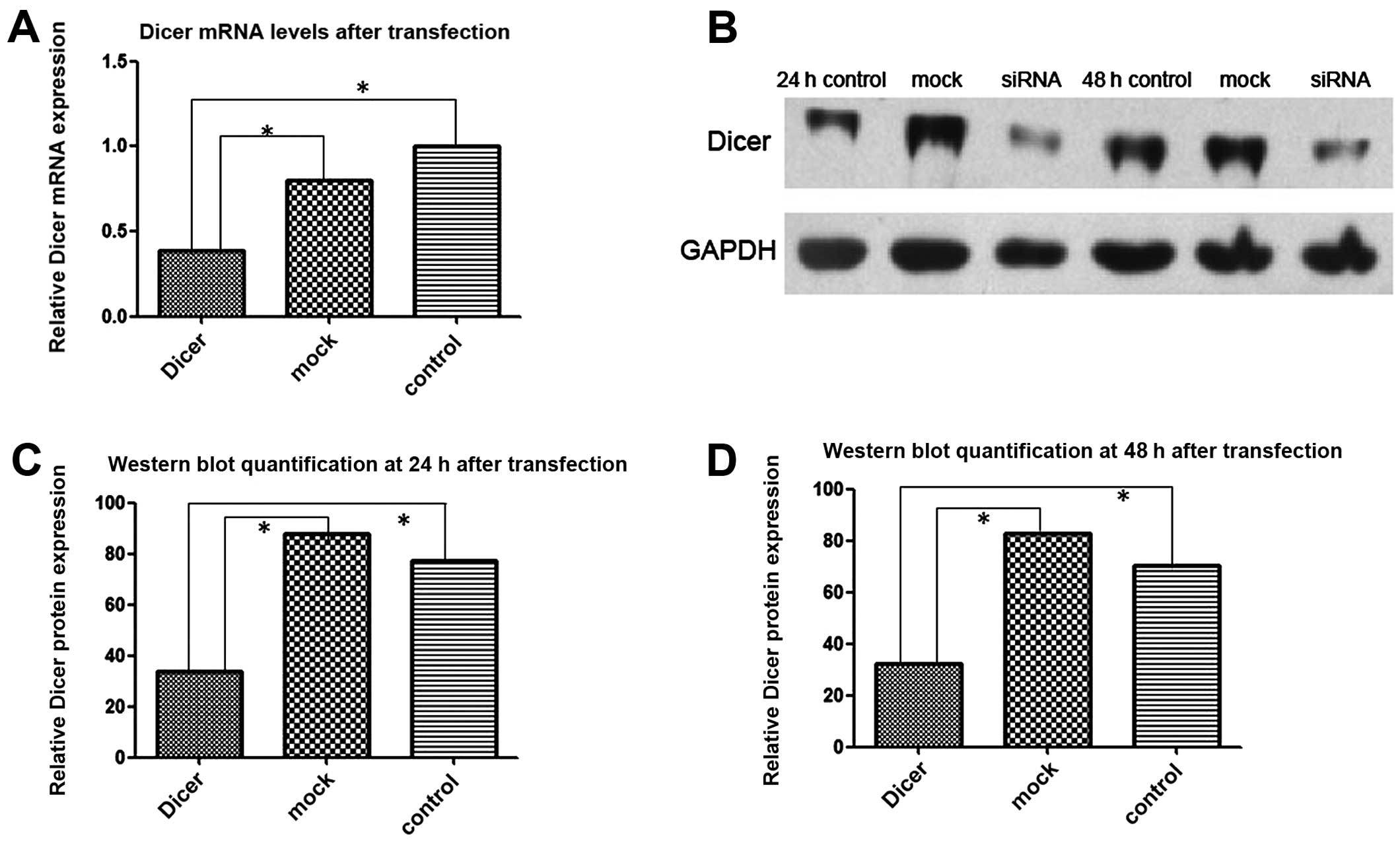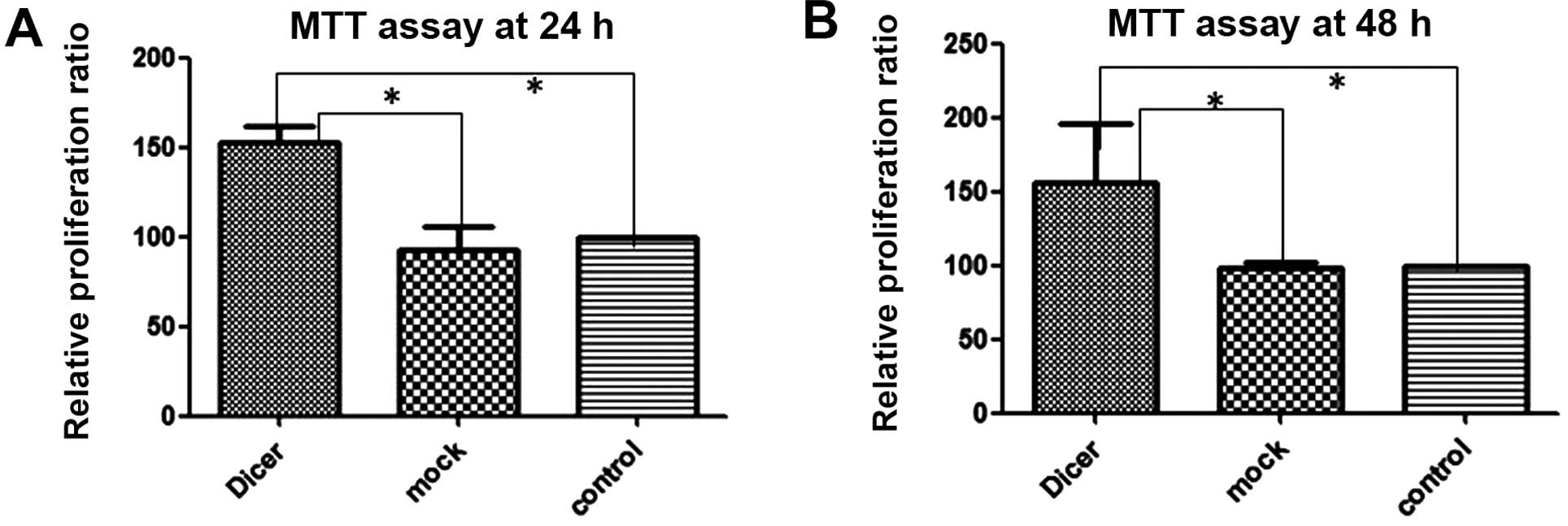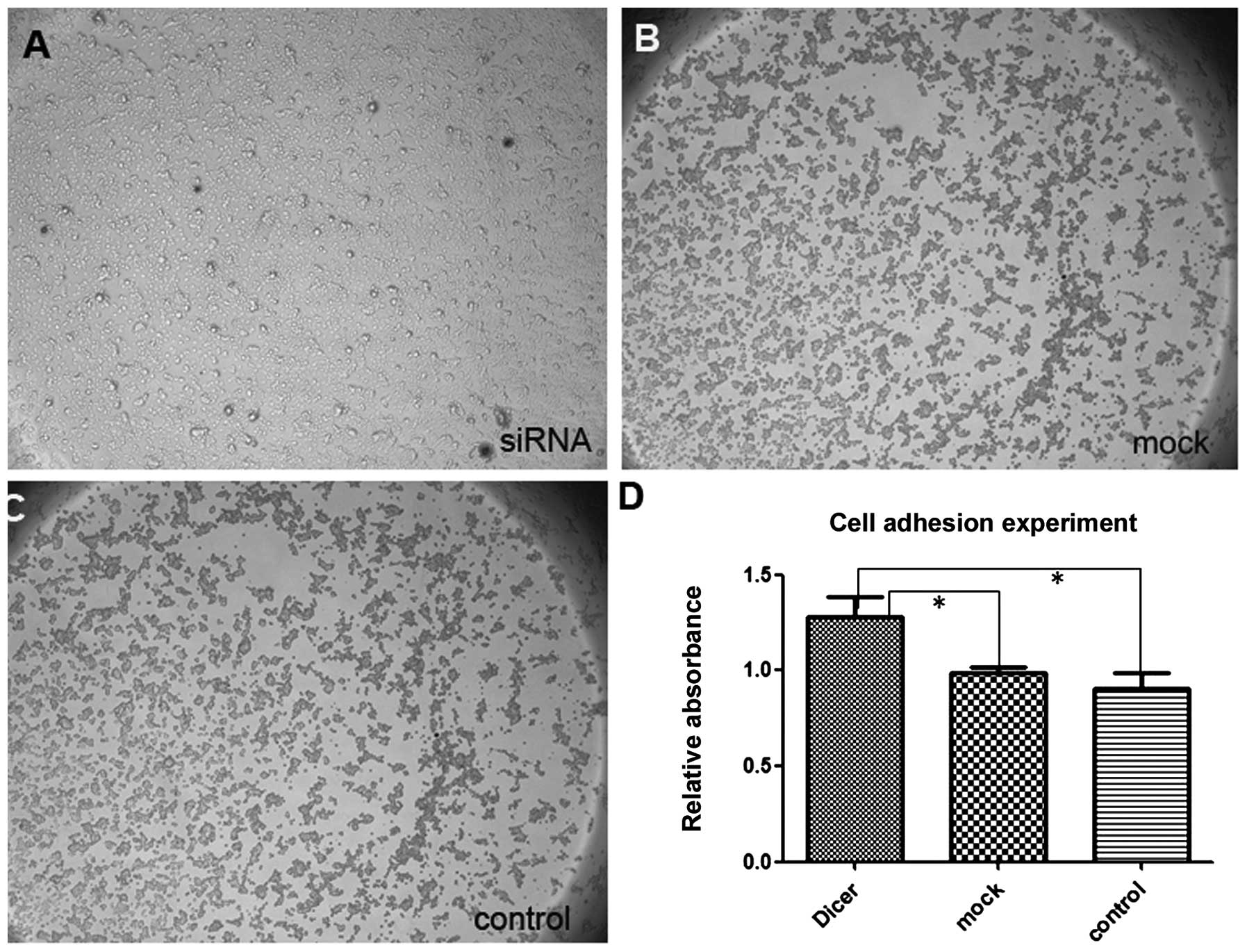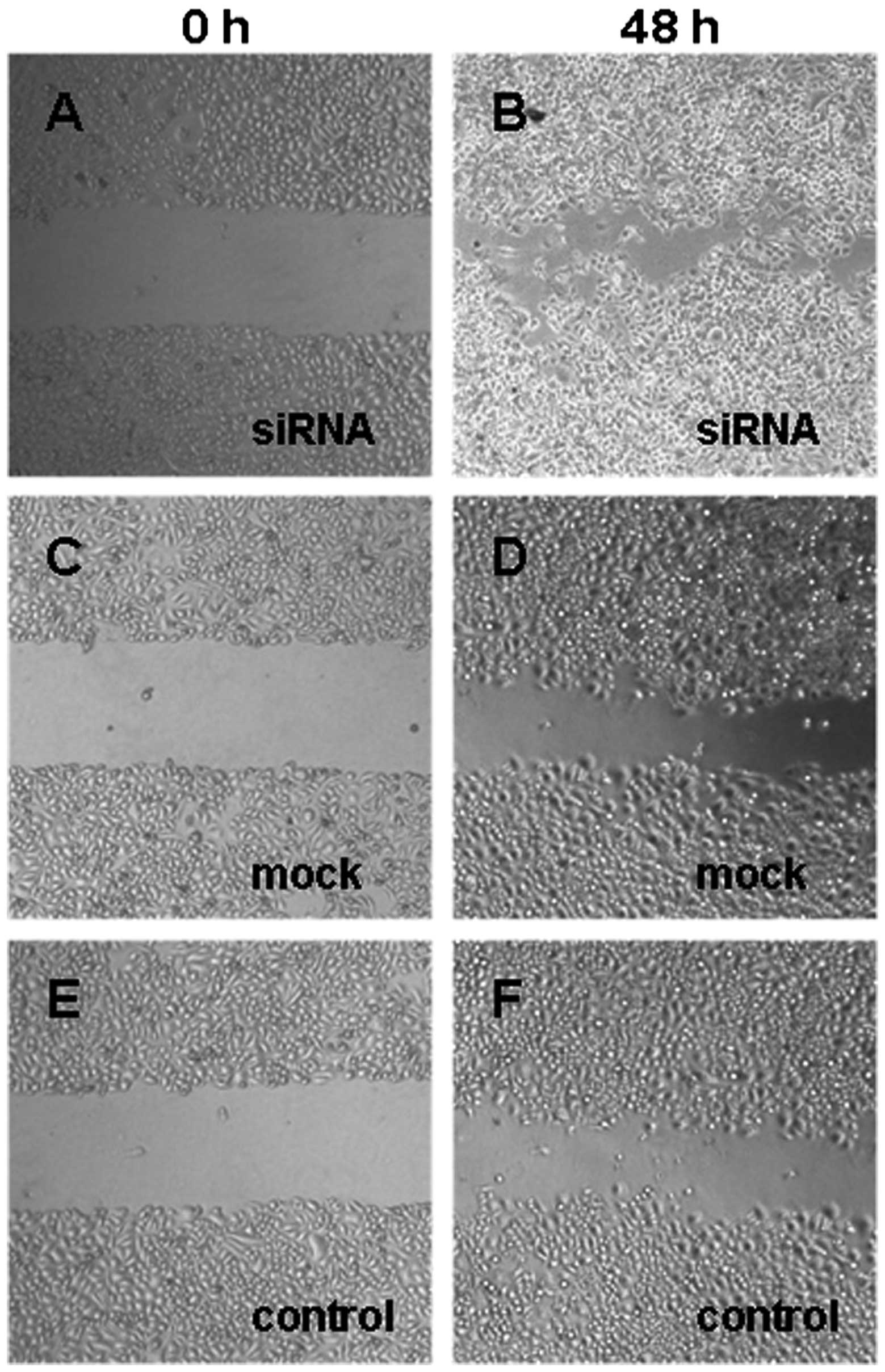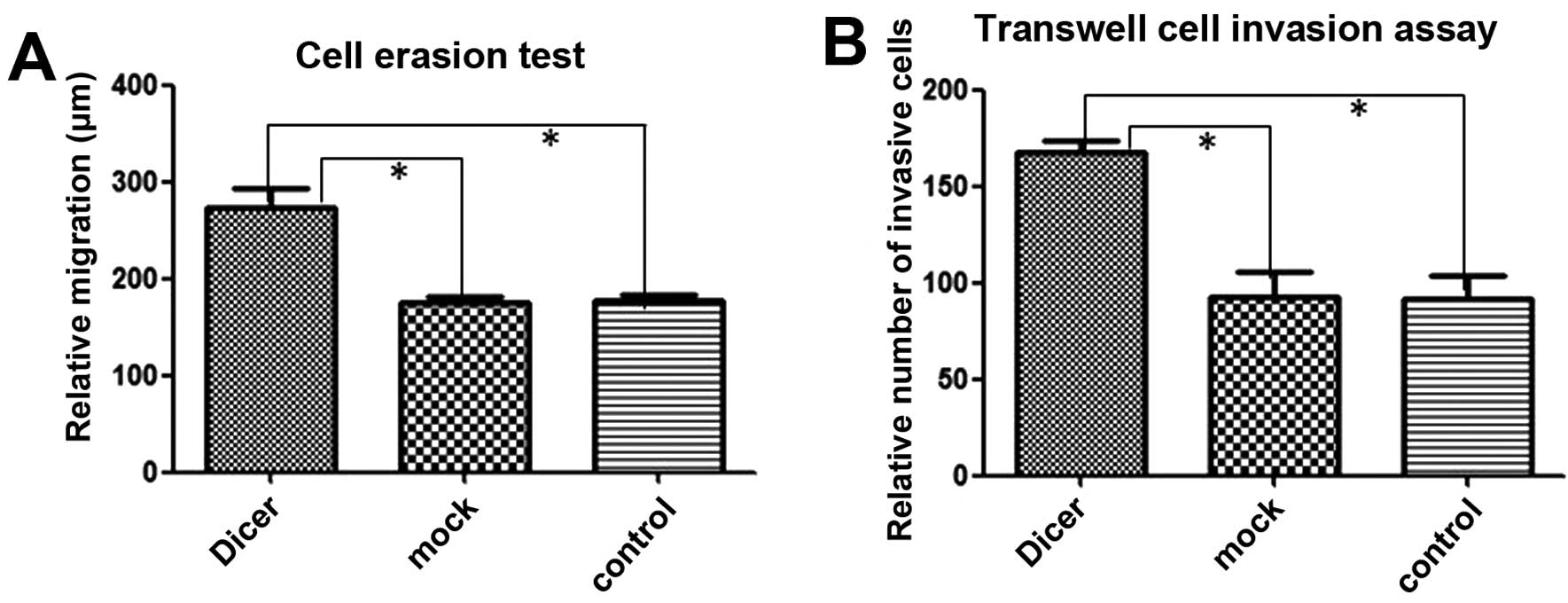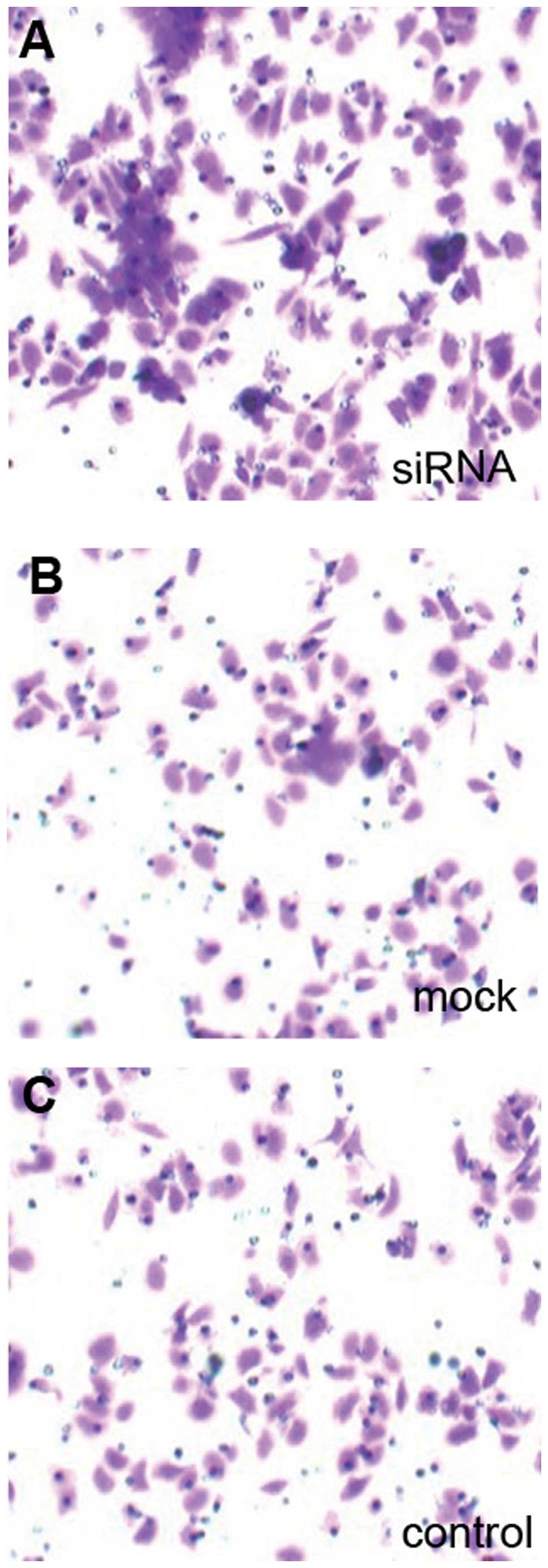Silencing Dicer expression enhances cellular proliferative and invasive capacities in human tongue squamous cell carcinoma
- Authors:
- Published online on: December 6, 2013 https://doi.org/10.3892/or.2013.2903
- Pages: 867-873
Abstract
Introduction
microRNAs (miRNAs) are small non-coding RNAs (~22 nt) that regulate the expression of target genes by promoting RNA cleavage or inhibiting RNA translation. Dicer, a key member of the RNase III family, is an essential component of the miRNA-processing machinery in the cytoplasm in which the precursors of miRNAs are processed by Dicer into mature miRNAs (1). The abnormal expression of miRNAs is associated with the development and progression of cancer (2,3). Dicer is aberrantly expressed in different types of cancer, and, being an upstream regulator of miRNAs, Dicer may affect the behavior of cancer by altering the expression spectrum of miRNAs.
The miRNA expression spectrum varies with cancer types, although in most types of cancer miRNAs are globally downregulated (4). However, whether the reduction in miRNA expression promotes cancer development or merely reflects the state of undifferentiated tumors is unclear. Markedly, tumor behaviors have been reported to be altered after silencing Dicer expression in vitro (5,6), but little evidence is available regarding the expression patterns of Dicer in tongue squamous cell carcinoma or the influence of knocking down Dicer expression on this type of cancer. In the present study, we first compared Dicer protein and mRNA expression between 2 carcinoma cell lines, Tca-8113 (7,8) and UM-1 (8,9) and normal gingival epithelial cells. We found that Dicer protein levels were lower in the carcinoma cells than in normal cells, and that Dicer expression was the lowest in the highly aggressive UM-1 cancer cells. Thus, we knocked down the expression of Dicer in Tca-8113 cells using siRNA transfection in vitro to investigate how disrupting Dicer-dependent maturation of miRNAs affects cell proliferation, cell cycle patterns and cell migration and invasion to affect cancer development.
Materials and methods
Cell culture and siRNA transfection
Normal gingival epithelial cells were purchased from the American Type Culture Collection (ATCC; Manassas, VA, USA). Tca-8113 and UM-1 were kindly provided by Dr AnXun Wang (The First Hospital Affiliated with Sun Yat-Sen University, Guangzhou, China). Cells were grown in minimal essential medium containing dimethyl sulfoxide (DMSO); media used were MEM for normal gingival epithelial cells, RPMI-1640 for Tca-8113 cells, and DMEM for UM-1 cells, all supplemented with 10% fetal bovine serum (FBS; Gibco). Dicer siRNA and negative-control siRNA were synthesized by Shanghai Jima Co. (Shanghai, China). The target sequences for Dicer siRNA were: 5′-GCCAAGGAAAUCAGCUAAATT-3′ and 5′-UUUAGCU GAUUUCCUUGGCTT-3′. The negative-control siRNA sequences were: 5′-UUCUCCGAACGUGUCACGUTT-3′ and 5′-ACGUGACACGUUCGGAGAATT-3′.
One day before transfection, Tca-8113 cells were re-plated in 6-well plates to obtain 50–80% confluence on the day of transfection. A complex of siRNAs (100 nM) and 5 μl Lipofectamine RNAiMAX reagent (Invitrogen) was added into each well according to the manufacturer’s instructions. Transfection efficiency was estimated 6 h later using fluorescence microscopy. Transfections were performed in triplicate for each treatment.
Real-time quantitative PCR analysis
Total RNA was extracted using TRIzol reagent (following the manufacturer’s instructions; Invitrogen) from normal gingival epithelial cells, Tca-8113 cells, UM-1 cells and 3 groups of Tca-8113 cells: cells transfected with Dicer-siRNA and negative-control siRNA and non-transfected cells. From the total RNA, cDNAs were synthesized using the Takara PrimeScript RT reagent (Perfect Real-Time kit) under reaction systems for 500 ng and 10 μl. The qPCR primer sequences used in the study were: Dicer forward primer, 5′-TGTGGGGAGAGGGCTGCTCA-3′ and reverse primer, 5′-GGCACAGGGCCTTTTCCCGA-3′; GAPDH forward primer, 5′-AAGGTGAAGGTCGGAGTCA AC-3′ and reverse primer, 5′-GGGGTCATTGATGGCAACA ATA-3′.
GAPDH was used as an internal control. PCR was performed in triplicate in a total reaction volume of 20 μl, which included 10 μl of the 2X reaction mix, 0.4 μl of 50X Rox, 3 μl of primer (2 μM), 5.6 μl of water and 1 μl of cDNA, with SYBR Premix Ex Taq kit. The PCR protocol used involved denaturation for 30 sec at 95°C, followed by amplification for 40 cycles, each cycle consisting of 5 sec at 95°C, 30 sec at 56°C and 30 sec at 72°C. The median in each triplicate was used to calculate the relative Dicer expression level using the comparative ΔCt method [value of 2−ΔCt (Dicer or GAPDH)]; fold-changes in expression were calculated using 2−ΔΔCt.
Western blotting
Total proteins were extracted from normal gingival epithelial cells, Tca-8113 cells, UM-1 cells and the 3 groups of Tca-8113 cells (transfected with Dicer-siRNA and negative-control siRNA and non-transfected) after transfection for 24 and 48 h. Cells were washed thrice with phosphate-buffered saline (PBS) before being lysed on ice in 50 μl 1X extraction buffer prepared fresh. Following centrifugation for 10 min, supernatants were collected and aliquots were withdrawn for detecting proteins using Micro BCA™ protein assay reagent kit according to the manufacturer’s instructions. SDS-PAGE (10% gels) was used to resolve proteins (40 μg/lane), which were transferred electrophoretically for 2 h to polyvinylidene difluoride membranes. Membranes were blocked for 1 h in PBS-Tween (0.1%) containing 5% non-fat milk, probed overnight at 4°C with primary antibodies (rabbit anti-human Dicer, 1:500; Sigma, St. Louis, MO, USA), and then incubated for 1 h with secondary antibodies (goat anti-rabbit IgG, 1:1,000; Wuhan Boster Biological Technology, Ltd., Wuhan, China) for visualizing protein bands using enhanced chemiluminescence. Results shown are representative from experiments repeated at least twice.
Immunohistochemical staining
Dicer was labeled in normal gingival epithelial cells, Tca-8113 and UM-1 cells that had reached 80% confluence. Labeling with anti-human Dicer (Sigma) and secondary anti-rabbit IgG (Wuhan Boster Biological Technology) was according to the manufacturer’s protocols using the SV-002 2-step-method Immunohistochemistry kit.
MTT assay
Cells were plated in 96-well plates at a density of 2,000 cells/well in 100 μl of culture medium and maintained until they adhered before carrying out transfections. After transfection with siRNAs at 37°C for 4 h, cells were incubated with 20 μl of MTT solution (5 mg/ml) for 24 and 48 h. At the end of the incubation, media were aspirated, 200 μl of DMSO was added to each well and the absorbance at 570 nm was measured. Mean absorbance from 3 replicate wells was determined, and cell viability was defined as (absorbance of treated cells)/(absorbance of control cells).
Cell cycle analysis
The 3 groups of cells were harvested 24 h after transfection with siRNA; cells were fixed overnight with 70% cold ethanol, washed twice with cold PBS, and then incubated in RNase A (10 mg/ml) for 1 h at 37°C. Propidium iodide (PI) 100 μg/ml was added and mixed for 30 min and then the cells were used for flow cytometric analysis.
Cell adhesion test, Erasion Trace test and Transwell cell-invasive assay
Matrigel (50 μl) diluted with RPMI-1640 (1:5) was added to 96-well plates and maintained at 4°C overnight. The next day, plates were sealed at 37°C for 1 h after replacing the fluid in the wells with 100 μl of RPMI-1640 containing 1% BSA. Experimental and control cells were plated without serum in the wells and incubated for 1 h, and the cells that did not adhere to the Matrigel were washed off using PBS. Next, 20 μl of MTT with 100 μl of RPMI-1640 was added to each well and incubated for 4 h. At the end of the incubation, the solution was aspirated, 200 μl of DMSO was added to each well, and the absorbance at 570 nm was measured; mean absorbance was determined from 3 replicate wells.
When attached, transfected cells were 80% confluent in 24-well plates, the culture medium was replaced with basic medium, and a 100-μl pipette tip was used to scrape cells in the middle of the wells. The scraped cells were washed off using PBS and the plates were placed in a 37°C incubator for 48 h. Distances migrated by cells across the middle of the wells were calculated by examining cells from 5 fields selected randomly under the microscope.
To the top chamber of a Transwell chamber, 30 μl of Matrigel diluted with RPMI-1640 (1:3) was added and maintained at 37°C and allowed to polymerize. Transfected cells were trypsinized and adjusted to a concentration of 5×105 cells/ml in RPMI-1640, and 200 μl of the resuspended cell solution was added to the top chamber above the Matrigel. The bottom chamber was filled with 600 μl of RPMI-1640 containing 10% serum. The Transwell plates were incubated at 37°C for 24 h and then the top chamber was removed and the Matrigel with unmigrated cells was gently scraped with a wet cotton swab. Cells were stained with 0.1% crystal violet for 5 min, washed with PBS to remove excess stain, and the average number of cells per field that had migrated was quantified under the microscope. The assay was repeated using the Transwell chamber without Matrigel.
Statistical analysis
SPSS-13.0 software, variance analysis, and 2 independent t-tests were used to analyze the differences in Dicer expression between the 3 types of cells and to evaluate the biological responses in treated and control cells.
Results
Dicer is downregulated in tongue squamous cell carcinoma cell lines
The relative expression levels of Dicer mRNA and protein were evaluated in normal oral gingival epithelial cells and 2 tongue squamous cell carcinoma cell lines, Tca-8113 and UM-1 cells (Figs. 1 and 2). Real-time qPCR showed that more Dicer mRNA was present in normal oral gingival cells than in Tca-8113 cells (P=0.020) and UM-1 cells (P=0.002). Western blotting showed that the amount of Dicer protein was significantly less in the 2 tongue squamous cell lines than in normal gingival epithelial cells (P=0.000 for both Tca-8113 and UM-1 cells). Dicer mRNA levels in Tca-8113 and UM-1 were not significantly different (P=0.166), but the amount of Dicer protein in the highly aggressive carcinoma cell line UM-1 was less than in Tca-8113 cells (P=0.000). Lastly, these results were further confirmed by the immunohistochemical staining for Dicer in the cells.
RNAi knocks down Dicer expression in Tca-8113 cells
FAM-labeled siRNAs were transfected into Tca-8113 cells and 6 h later the transfection efficiency was determined using fluorescence microscopy. Approximately 80% of the transfected cells emitted green fluorescence upon excitation. Total cellular RNAs from Dicer siRNA-transfected cells and control cells (negative-control-siRNA transfected and non-transfected) were extracted 24 h after transfection. RT-PCR showed that the level of Dicer mRNA in the Dicer-siRNA group was significantly lower than in the 2 control groups (P=0.000). Similarly, western blotting demonstrated that the Dicer protein amount was substantially lower in the Dicer-siRNA group than in the 2 control groups at 24 and 48 h after transfection (Fig. 3).
Silencing Dicer promotes cell proliferation and cell cycle
To investigate the impact of Dicer on the proliferative capacity of cells, we measured the effects of Dicer-siRNA transfection on cell proliferation using the MTT assay and on cell cycle progression by using flow cytometry following PI staining. The MTT assay (Fig. 4) demonstrated that transfection with Dicer-siRNA increased Tca-8113 cell proliferation at 24 and 48 h after transfection relative to the 2 controls (negative-control siRNA transfected and non-transfected cells). Moreover, cell cycle analysis revealed that in Tca-8113 cells transfected with Dicer-siRNA, the rate of S+G2 phases increased sharply accompanied by a reduction in G1 phase (Fig. 5; Table I), indicating that the depletion of Dicer accelerated the cell cycle (to S and G2 phases).
Silencing Dicer expression increases cell migration and invasion
To examine how silencing Dicer expression affects the migratory and invasive abilities of Tca-8113 cells, we quantified cell migration using cell adhesion and Erasion Trace tests and the Transwell cell-invasive assay. Compared to the control cells, more cells that had been transfected with Dicer-siRNA adhered to the Matrigel, migrated through the Transwell membrane and covered the erased trace better. Absorbance at 570 nm in the Matrigel adhesion test for Dicer-siRNA cells was 1.277±0.109 compared to 0.990±0.026 and 0.905±0.079 for negative-control siRNA cells and non-transfected cells, respectively (P=0.011, P=0.009; Fig. 6). Similarly, Dicer-siRNA cells migrated more and covered the erased trace to 273.42±18.95 μm compared to 175.76±5.81 μm and 178.14±5.01 μm for cells transfected with the negative-control siRNA and non-transfected cells, respectively (P=0.000, P=0.000; Figs. 7 and 9A). Furthermore, Dicer-siRNA transfection increased Transwell migration to 167.20±6.38 cells from 92.40±13.22 cells and 91.60±11.61 cells in negative-control siRNA cells and non-transfected cells, respectively (P=0.000, P=0.000; Figs. 8 and 9B). Therefore, transfecting Dicer-siRNA into Tca-8113 cells increased cell migration and invasion in vitro to levels significantly greater than in cells transfected with the negative-control siRNA and in non-transfected cells. Collectively, our results suggest that knocking down Dicer expression in Tca-8113 cells increases the invasive and proliferative capacities of these cells.
Discussion
Dicer, a member of RNase III family essential for miRNA processing, is known to be associated with cancer. Dicer is upregulated in prostate, colorectal cancer and lung squamous cell carcinoma (1,10–14), and is downregulated in hepatocellular carcinoma, gastric, breast and ovarian cancer (15–18). Dicer is mis-expressed in different types of cancer, and Dicer expression changes are biomarkers of poor prognostics for cancer patients.
Cancer can be promoted or suppressed by miRNAs (19). In certain types of cancer, miRNAs are upregulated (20), but in most cancers the miRNAs are globally downregulated, and this downregulation plays a key role in the phenotypic transformation of cancer (4). Since Dicer is an upstream regulator of miRNAs, the mis-expression of Dicer in cancer can partly explain the abnormal expression of miRNAs in the cancer cells, and several studies have demonstrated changes in cancer behavior after silencing Dicer both in vivo and in vitro. For instance, knocking down Dicer in breast cancer can lead to a more malignant and invasive phenotype in vitro (21). Moreover, in animal studies, silencing Dicer in the mouse model of lung cancer using K-Ras promoted the development of the cancer, and suppressing the expression of Dicer contributed to liver cancer in mice (22,23). However, no evidence thus far has suggested a role of Dicer in tongue squamous cell carcinoma.
We found that Dicer was expressed at lower levels in 2 cell lines of tongue squamous cell carcinoma (Tca-8113 and UM-1 cells) compared to normal gingival epithelial cells, which supports the theory that miRNAs are downregulated in cancer due to the suppression of Dicer expression. Our results further link Dicer downregulation and the potential impairment of miRNA processing with the transformation of tumor cells; we also demonstrated that depletion of Dicer, a key component in the miRNA processing machinery in cells, enhanced malignant transformation of tongue squamous carcinoma cells. Specifically, knocking down Dicer in Tca-8113 cells significantly increased the proliferative ability, G1 arrest and invasiveness of the cells.
Collectively, our results suggest that Dicer functions as an indirect tumor suppressor, as silencing Dicer expression makes cancer cells more malignant. Although the mechanism of this transformation remains elusive, the present study suggests that rectifying the aberrant expression of Dicer could be one approach in treating tongue squamous cell carcinoma.
Acknowledgements
This study was supported by a grant from Guangdong Provincial International Science and Technology Cooperation Project (2012B050300028). The authors thank Dr AnXun Wang for providing the tongue squamous carcinoma cell lines (Tca-8113 and UM-1), and Professor Jun Xia from the Hong Kong University of Science and Technology for collaboration and guidance in the research.
References
|
Macrae IJ, Zhou K, Li F, et al: Structural basis for double-stranded RNA processing by Dicer. Science. 211:195–198. 2006. View Article : Google Scholar : PubMed/NCBI | |
|
Si ML, Zhu S, Wu H, et al: miR-21-mediated tumor growth. Oncogene. 26:2799–2803. 2007. View Article : Google Scholar : PubMed/NCBI | |
|
Shi B, Sepp-Lorenzino L, Prisco M, et al: MicroRNA-145 targets the insulin receptor substrate-1 and inhibits the growth of colon cancer cells. J Biol Chem. 282:32582–32590. 2007. View Article : Google Scholar : PubMed/NCBI | |
|
Lu J, Getz G, Miska EK, et al: MicroRNA expression profiles classify human cancers. Nature. 435:834–838. 2005. View Article : Google Scholar : PubMed/NCBI | |
|
Bu Y, Lu C, Bian C, et al: Knockdown of Dicer in MCF-7 human breast carcinoma cells results in G1 arrest and increased sensitivity to cisplatin. Oncol Rep. 21:13–17. 2009.PubMed/NCBI | |
|
Han L, Zhang A, Zhou X, et al: Downregulation of Dicer enhances tumor cell proliferation and invasion. Int J Oncol. 37:299–305. 2010.PubMed/NCBI | |
|
Liu Tian-Run, Xu Li-Hua, Yang An-Kui, et al: Decreased expression of SATB2: a novel independent prognostic marker of worse outcome in laryngeal carcinoma patients. PLoS One. 7:e407042012. View Article : Google Scholar : PubMed/NCBI | |
|
Jiang Lu, Dai Yang, Liu Xiqiang, et al: Identification and experimental validation of G protein alpha inhibiting activity polypeptide 2 (GNAI2) as a microRNA-138 target in tongue squamous cell carcinoma. Hum Genet. 129:189–197. 2011. View Article : Google Scholar | |
|
Nakayama S, Sasaki A, Mese H, Alcalde RE and Matsumura T: Establishment of high and low metastasis cell lines derived from a human tongue squamous cell carcinoma. Invasion Metastasis. 18:219–228. 1999. View Article : Google Scholar : PubMed/NCBI | |
|
Chiosea S, Jelezcova E, Chandran U, et al: Up-regulation of Dicer, a component of the microRNA machinery, in prostate adenocarcinoma. Am J Pathol. 169:1812–1820. 2006. View Article : Google Scholar : PubMed/NCBI | |
|
Faber C, Horst D, Hlubek F, et al: Overexpression of Dicer predicts poor survival in colorectal cancer. Eur J Cancer. 47:1414–1419. 2011. View Article : Google Scholar : PubMed/NCBI | |
|
Papachristou DJ, Korpetinou A, Giannopoulou E, et al: Expression of the ribonucleases Drosha, Dicer, and Ago2 in colorectal cancinomas. Virchows Arch. 459:431–440. 2011. View Article : Google Scholar : PubMed/NCBI | |
|
Stratmann J, Wang CJ, Gnosa S, et al: Dicer and miRNA in relation to clinicopathological variables in colorectal cancer patients. BMC Cancer. 11:3452011. View Article : Google Scholar : PubMed/NCBI | |
|
Chiosea S, Jelezcova E, Chandran U, et al: Overexpression of Dicer in precursor lesions of lung adenocarcinoma. Cancer Res. 67:2345–2450. 2007. View Article : Google Scholar : PubMed/NCBI | |
|
Wu JF, Shen W, Liu NZ, et al: Down-regulation of Dicer in hepotocellular carcinoma. Med Oncol. 28:804–809. 2011. View Article : Google Scholar : PubMed/NCBI | |
|
Grelier G, Voirin N, Ay AS, et al: Prognostic value of Dicer expression in human breast cancers and association with the mesenchymal phenotype. Br J Cancer. 101:673–683. 2009. View Article : Google Scholar : PubMed/NCBI | |
|
Yan M, Huang HY, Wang T, et al: Dysregulated expression of dicer and drosha in breast cancer. Pathol Oncol Res. 18:343–348. 2012. View Article : Google Scholar : PubMed/NCBI | |
|
Pampalakis G, Diamandis EP, Katsaros D, et al: Down-regulation of dicer expression in ovarian cancer tissues. Clin Biochem. 43:324–327. 2010. View Article : Google Scholar : PubMed/NCBI | |
|
Volinia S, Calin GA, Liu CG, et al: A microRNA expression signature of human solid tumors defines cancer gene targets. Proc Natl Acad Sci USA. 103:2257–2261. 2006. View Article : Google Scholar : PubMed/NCBI | |
|
Kumar MS, Lu J, Mercer KL, et al: Impaired microRNA processing enhances cellular transformation and tumorigenesis. Nat Genet. 39:673–677. 2007. View Article : Google Scholar : PubMed/NCBI | |
|
Martello G, Rosato A, Ferrari F, et al: A MicroRNA targeting dicer for metastasis control. Cell. 141:1195–1207. 2010. View Article : Google Scholar : PubMed/NCBI | |
|
Iwanaga K, Yang Y, Raso MG, et al: Pten inactivation accelerates oncogenic K-ras-initiated tumorigenesis in a mouse model of lung cancer. Cancer Ras. 68:1119–1127. 2008.PubMed/NCBI | |
|
Sekine S, Ogawa R, Ito R, et al: Disruption of Dicer1 induces dysregulated fetal gene expression and promotes hepatocarcinogenesis. Gastroenterology. 136:2304–2315. 2009. View Article : Google Scholar : PubMed/NCBI |



